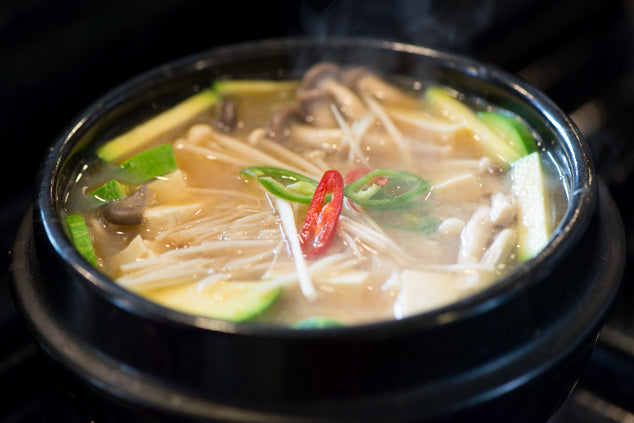Five Korean Ingredients You Need In Your Storecupboard Now

South Korean flavours are distinct from any other cuisine. Cooking techniques and recipes may look similar to those in Japan, with rich umami notes and a shared fondness for fermented sauces and condiments. Yet in South Korea there is also intense pungency and chilli heat.
Pickled garlic and vinegared chilli sauce are served with finely cut raw fish in Korea, instead of just the hint of salty soy sauce and wasabi for seasoning sashimi in Japan. Fiery hot and sour fizzy cabbage kimchi accompany every meal in Korea, instead of merely salted pickles with plain rice in Japan.
The ingredients are key to Korea's unique flavours - when mixing a sauce for the famous rice dish bibimbap there just isn't a substitute for the fermented red pepper paste gochujang. And gochugaru chilli powder used to make kimchi is intensely coloured with a uniquely coarse grind, mild heat and hint of acidity.
This is the list of the five store cupboard ingredients you need to start cooking Korean food.
Korean red chill bean paste - or gochujang is perhaps the most famous Korean condiment - spicy, sweet and rich in umami, it is receiving world renown. A spoonful of gochujang is the classic condiment for the Korean rice dish bibimbap; mixed with vinegar, gochujang is served as a dipping sauce with sashimi; and in the USA it is most famously the base of sauce for Korean Fried Chicken (KFC for short!). And gochujang is frequently stirred together with doenjang (see below) to make ssamjang sauce served with Korean BBQ.

There just isn't another sauce like it - you'll just have to try the real thing.
Doenjang is a salty umami rich paste similar to Japanese miso paste. It is a key ingredient in sauces (such as ssamjang, when mixed in equal parts with gochujang above), salad dressings and in soup bases.

Doenjang jigae stew - a hearty vegetable broth enriched with umami-rich doenjang
Doenjang is made from cooked soy beans, pounded and formed into large blocks that are hung up to dry in the sun. Water and salt is added to the dried blocks and the mixture continues to ferment. The protein-rich liquid is drained off to make soy sauce, and the solid mass which remains is doenjang.
Doenjang is similar to Japanese miso - the solids left after fermenting soybean and draining away liquid soy sauce
Kimchi is present with almost every meal in a Korean restaurant - breakfast, lunch or dinner. And with the increasing number of great Korean American chefs, kimchi is starting to be included in many other dishes worldwide - kimchi stirred into steak tartare, kimchi tacos, and hotdogs with kimchi mayo.

Large pieces of cabbage kimchi laid out on at an outdoor Korean BBQ restaurant in Seoul - to be wrapped up with the beef in a lettuce leaf. Kimchi is usually served straight from a jar, but cooking kimchi on a BBQ deepens the flavour.
Kimchi is a side dish made with pickled vegetables and chilli powder, left to ferment until slightly fizzy - not unlike sauerkraut. The lactic acid bacteria which form during fermentation are believed to be wonderful for the digestion, and if friends' amazing skin upon return trips to Korea is anything to go by, the all-round health benefits of kimchi are everything they are thought to be! See our article Kimchi - Korea's Greatest Food? for more of the famous condiment's history.
You can buy kimchi in a jar for store-cupboard emergencies, but it is also very easy to make at home. Home made kimchi uses vegetables (most often cabbage) and the other key ingredients of gochugaru (below) and anchovy extract.
Korean food is famed for its intense red colour and chilli heat - all of which comes from Korean red pepper powder, gochugaru. In early times, Korean dishes were mostly spiced with pungent vegetables such as garlic and chives. However when chilli came to Korea during the 17th Century via the Japanese from Portugal, and it became a huge part of the Korean diet. Gochugaru red pepper powder is now an ingredient in most South Korean dishes - from Kimchi to dipping sauces, and from stews to Korean banchan side dishes.

Fermented seafood with gochugaru red pepper powder, at Noryangjin Fisheries wholesale market in Seoul
Gochugaru has a uniquely mild and slightly acidic citrussy heat. The large flakes also make an attractive garnish for dishes. The large shaker pots are great value, and will last well.
Sesame oil is in so many Korean dishes - used to fry rice in dolsot bibimbap, to bring rounded depth to dipping sauces in, and together with garlic and soy sauce as an all purpose dressing for vegetables (see spinach banchan recipe). The flavour of the sesame oil is hugely important, and so many bottles that are widely available taste nasty - acrid or sharp, without any of the toasted sesame smoothness and warmth. Looking for 'pure sesame oil' helps, but isn't any guarantee of quality. We use this sesame oil in all our Korean cooking.
You might also like to try chunjang black bean paste, which adds sweetness and umami depth to stir fries and sauces.







